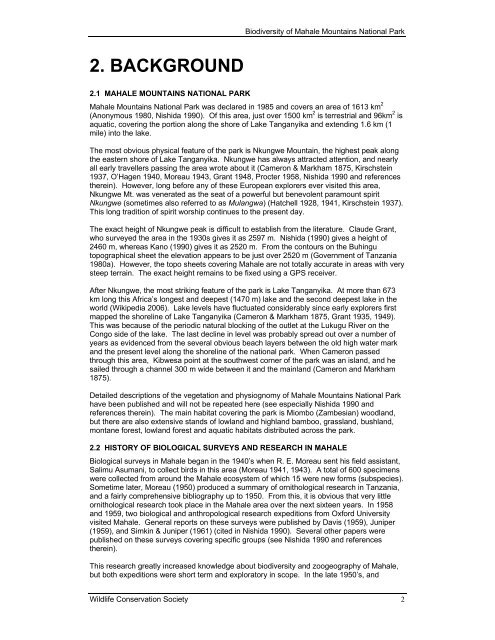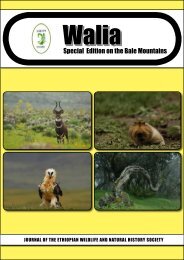Biodiversity of Mahale Mountains National Park, Tanzania | Report ...
Biodiversity of Mahale Mountains National Park, Tanzania | Report ...
Biodiversity of Mahale Mountains National Park, Tanzania | Report ...
Create successful ePaper yourself
Turn your PDF publications into a flip-book with our unique Google optimized e-Paper software.
2. BACKGROUND<br />
<strong>Biodiversity</strong> <strong>of</strong> <strong>Mahale</strong> <strong>Mountains</strong> <strong>National</strong> <strong>Park</strong><br />
2.1 MAHALE MOUNTAINS NATIONAL PARK<br />
<strong>Mahale</strong> <strong>Mountains</strong> <strong>National</strong> <strong>Park</strong> was declared in 1985 and covers an area <strong>of</strong> 1613 km 2<br />
(Anonymous 1980, Nishida 1990). Of this area, just over 1500 km 2 is terrestrial and 96km 2 is<br />
aquatic, covering the portion along the shore <strong>of</strong> Lake Tanganyika and extending 1.6 km (1<br />
mile) into the lake.<br />
The most obvious physical feature <strong>of</strong> the park is Nkungwe Mountain, the highest peak along<br />
the eastern shore <strong>of</strong> Lake Tanganyika. Nkungwe has always attracted attention, and nearly<br />
all early travellers passing the area wrote about it (Cameron & Markham 1875, Kirschstein<br />
1937, O’Hagen 1940, Moreau 1943, Grant 1948, Procter 1958, Nishida 1990 and references<br />
therein). However, long before any <strong>of</strong> these European explorers ever visited this area,<br />
Nkungwe Mt. was venerated as the seat <strong>of</strong> a powerful but benevolent paramount spirit<br />
Nkungwe (sometimes also referred to as Mulangwa) (Hatchell 1928, 1941, Kirschstein 1937).<br />
This long tradition <strong>of</strong> spirit worship continues to the present day.<br />
The exact height <strong>of</strong> Nkungwe peak is difficult to establish from the literature. Claude Grant,<br />
who surveyed the area in the 1930s gives it as 2597 m. Nishida (1990) gives a height <strong>of</strong><br />
2460 m, whereas Kano (1990) gives it as 2520 m. From the contours on the Buhingu<br />
topographical sheet the elevation appears to be just over 2520 m (Government <strong>of</strong> <strong>Tanzania</strong><br />
1980a). However, the topo sheets covering <strong>Mahale</strong> are not totally accurate in areas with very<br />
steep terrain. The exact height remains to be fixed using a GPS receiver.<br />
After Nkungwe, the most striking feature <strong>of</strong> the park is Lake Tanganyika. At more than 673<br />
km long this Africa’s longest and deepest (1470 m) lake and the second deepest lake in the<br />
world (Wikipedia 2006). Lake levels have fluctuated considerably since early explorers first<br />
mapped the shoreline <strong>of</strong> Lake Tanganyika (Cameron & Markham 1875, Grant 1935, 1949).<br />
This was because <strong>of</strong> the periodic natural blocking <strong>of</strong> the outlet at the Lukugu River on the<br />
Congo side <strong>of</strong> the lake. The last decline in level was probably spread out over a number <strong>of</strong><br />
years as evidenced from the several obvious beach layers between the old high water mark<br />
and the present level along the shoreline <strong>of</strong> the national park. When Cameron passed<br />
through this area, Kibwesa point at the southwest corner <strong>of</strong> the park was an island, and he<br />
sailed through a channel 300 m wide between it and the mainland (Cameron and Markham<br />
1875).<br />
Detailed descriptions <strong>of</strong> the vegetation and physiognomy <strong>of</strong> <strong>Mahale</strong> <strong>Mountains</strong> <strong>National</strong> <strong>Park</strong><br />
have been published and will not be repeated here (see especially Nishida 1990 and<br />
references therein). The main habitat covering the park is Miombo (Zambesian) woodland,<br />
but there are also extensive stands <strong>of</strong> lowland and highland bamboo, grassland, bushland,<br />
montane forest, lowland forest and aquatic habitats distributed across the park.<br />
2.2 HISTORY OF BIOLOGICAL SURVEYS AND RESEARCH IN MAHALE<br />
Biological surveys in <strong>Mahale</strong> began in the 1940’s when R. E. Moreau sent his field assistant,<br />
Salimu Asumani, to collect birds in this area (Moreau 1941, 1943). A total <strong>of</strong> 600 specimens<br />
were collected from around the <strong>Mahale</strong> ecosystem <strong>of</strong> which 15 were new forms (subspecies).<br />
Sometime later, Moreau (1950) produced a summary <strong>of</strong> ornithological research in <strong>Tanzania</strong>,<br />
and a fairly comprehensive bibliography up to 1950. From this, it is obvious that very little<br />
ornithological research took place in the <strong>Mahale</strong> area over the next sixteen years. In 1958<br />
and 1959, two biological and anthropological research expeditions from Oxford University<br />
visited <strong>Mahale</strong>. General reports on these surveys were published by Davis (1959), Juniper<br />
(1959), and Simkin & Juniper (1961) (cited in Nishida 1990). Several other papers were<br />
published on these surveys covering specific groups (see Nishida 1990 and references<br />
therein).<br />
This research greatly increased knowledge about biodiversity and zoogeography <strong>of</strong> <strong>Mahale</strong>,<br />
but both expeditions were short term and exploratory in scope. In the late 1950’s, and<br />
Wildlife Conservation Society 2
















